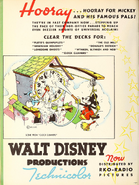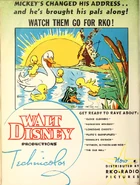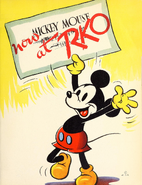



RKO (Radio-Keith-Orpheum) Pictures was an American film production and distribution company. As RKO Radio Pictures Inc., it was one of the Big Five studios of Hollywood's Golden Age. The business was formed after the Keith-Albee-Orpheum (KAO) theater chains and Joseph P. Kennedy's Film Booking Offices of America (FBO) studio were brought together under the control of the Radio Corporation of America (RCA) in October 1928.[a] RCA chief David Sarnoff engineered the merger to create a market for the company's sound-on-film technology, RCA Photophone. By the mid-1940's, the studio was under the control of investor Floyd Odlum.
RKO has long been celebrated for its series of musicals starring Fred Astaire and Ginger Rogers in the mid-to-late 1930s. Actors Katharine Hepburn and, later, Robert Mitchum had their first major successes at the studio. Cary Grant was a mainstay for years. The work of producer Val Lewton's low-budget horror unit and RKO's many ventures into the field now known as film noir have been acclaimed, largely after the fact, by film critics and historians. The studio produced two of the most famous films in motion picture history: King Kong and Citizen Kane.
Maverick industrialist Howard Hughes took over RKO in 1948. After years of decline under his control, the studio was acquired by the General Tire and Rubber Company in 1955. The original RKO Pictures ceased production in 1957 and was effectively dissolved two years later. In 1981, broadcaster RKO General, the corporate heir, revived it as a production subsidiary, RKO Pictures Inc. In 1989, this business with its few remaining assets, the trademarks and remake rights to many classic RKO films, was sold to new owners, who now operate the small independent company RKO Pictures LLC.
Soon after the appointment of a new production chief, Samuel Briskin, in late 1935, RKO entered into an important distribution deal with animator Walt Disney (Van Beuren consequently folded its cartoon operations). From 1936 to 1954, the studio released Disney features and shorts; Snow White and the Seven Dwarfs (1937) was the highest grossing movie in the period between The Birth of a Nation (1915) and Gone with the Wind (1939). Following the change in print branding a few years earlier, the opening and closing logos on RKO movies, other than the Pathé nonfiction line, were changed from "Radio Pictures" to "RKO Radio Pictures" in 1936. In February 1937, Selznick, now an independent producer, leased RKO's Culver City studio and Forty Acres backlot. In addition to its central Hollywood studio, RKO productions now revolved around its vast Encino movie ranch. While the Disney association was beneficial, RKO's own product was viewed as declining in quality and Briskin was gone by the end of the year. Convinced that the studio was sinking, Walt Disney ended his arrangement with RKO and set up his own distribution firm, Buena Vista Pictures.
Disney films distributed by RKO Radio Pictures
- Academy Award Review of Walt Disney Cartoons (1937; distribution only; produced by Walt Disney Productions)
- Snow White and the Seven Dwarfs (1937; distribution only; produced by Walt Disney Productions)
- Pinocchio (1940; distribution only; produced by Walt Disney Productions)
- Fantasia (1940; distribution only; produced by Walt Disney Productions)
- The Reluctant Dragon (1941; distribution only; produced by Walt Disney Productions)
- Dumbo (1941; distribution only; produced by Walt Disney Productions)
- Bambi (1942; distribution only; produced by Walt Disney Productions)
- Saludos Amigos (1942; distribution only; produced by Walt Disney Productions)
- The Three Caballeros (1944; distribution only; produced by Walt Disney Productions)
- Make Mine Music (1946; distribution only; produced by Walt Disney Productions)
- Song of the South (1946; distribution only; produced by Walt Disney Productions)
- Fun and Fancy Free (1947; distribution only; produced by Walt Disney Productions)
- Melody Time (1948; distribution only; produced by Walt Disney Productions)
- So Dear to My Heart (1948; distribution only; produced by Walt Disney Productions)
- The Adventures of Ichabod and Mr. Toad (1949; distribution only; produced by Walt Disney Productions)
- Cinderella (1950; distribution only; produced by Walt Disney Productions)
- Treasure Island (1950; distribution only; produced by Walt Disney Productions)
- Alice in Wonderland (1951; distribution only; produced by Walt Disney Productions)
- The Story of Robin Hood and His Merrie Men (1952; distribution only; produced by Walt Disney Productions)
- Peter Pan (1953; distribution only; produced by Walt Disney Productions)
- The Sword and the Rose (1953; distribution only; produced by Walt Disney Productions)
- Rob Roy, the Highland Rogue (1953; distribution only; produced by Walt Disney Productions)
- Music Land (1955; distribution only; produced by Walt Disney Productions)
- Mighty Joe Young (1998)



